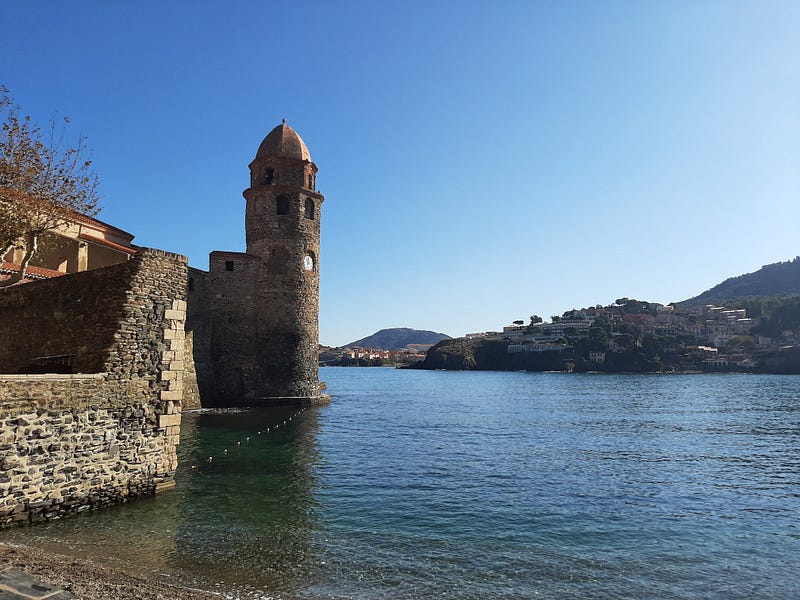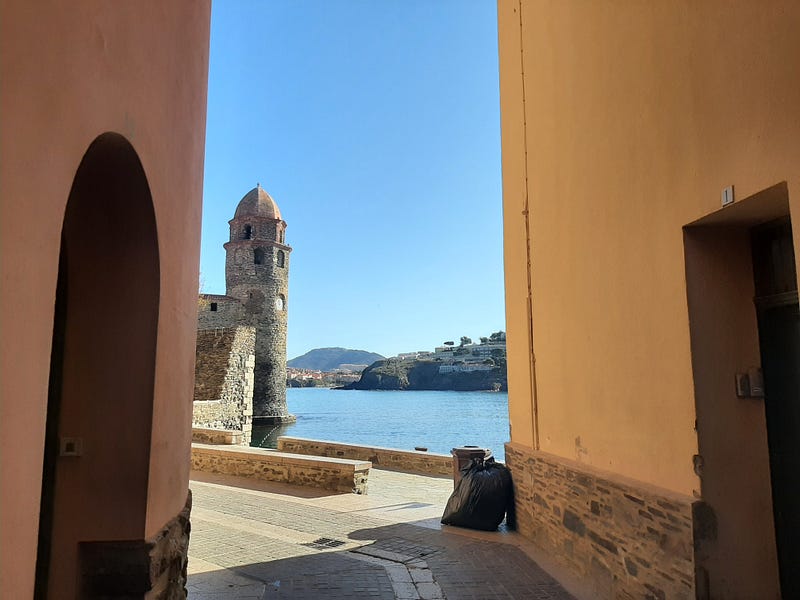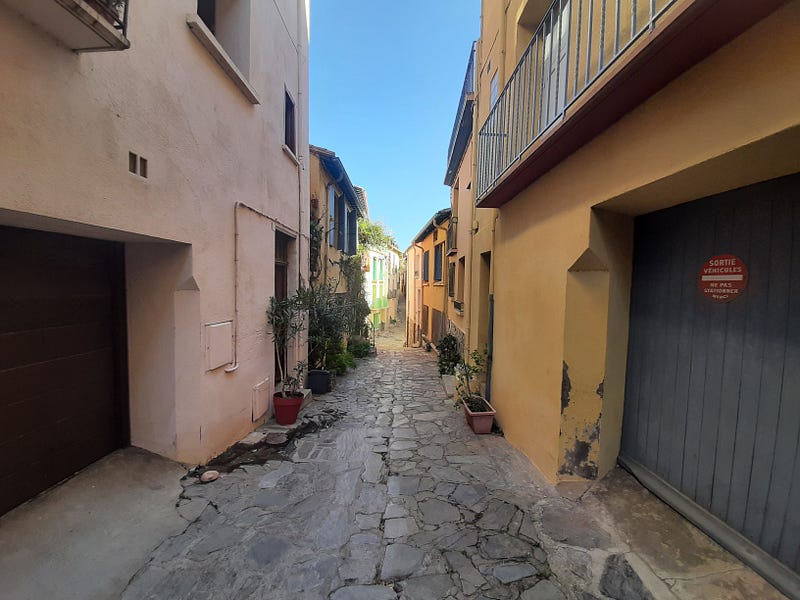A Journey Towards the Essence of Beauty in France
Written on

I need a more fitting term for blue
I could opt for the more intriguing term azure, represented by the hexadecimal #007FFF on the RGB color spectrum. This word, after all, made its way into English through French, as many sophisticated words do. However, the nuance runs deeper.
Azure is frequently characterized as the shade of a flawless blue sky, and while the sea seems to borrow its hue from the sky—much like a word shifts from one language to another—it’s not the same blue we witnessed when we rounded a twisty French street and beheld the Mediterranean unfolding before us, similar to how one's pupils dilate upon entering darkness.
Moreover, France is already home to the Azure Coast. Yet, this isn't Provence; it’s the Côte Vermeille, or the Vermillion Coast—a 20-kilometer stretch of rugged coastline extending from Argeles to the almost legendary border with Spain. And as any expert in color will tell you, vermillion is a muted orange-red, derived from the delightfully named mineral cinnabar.
I find myself at a disadvantage. I perceive color like any other human, possessing an ability to distinguish various hues that few mammals can rival, surpassed only by birds and insects. Nevertheless, I am a male. While I am not among the 8% of men who are colorblind, I lack the nuanced color perception that women often have. My wife perceives a different, likely more exquisite sea than I do, one that is better differentiated from the encompassing sky, with color variations that elude me.
Conversely, she cannot see its movement as I do.

Yet, no term I could conjure would encapsulate the precise blue of the Mediterranean as seen for the first time by someone who has journeyed a quarter of the globe for that very purpose. No word can convey the astonishment of spotting it at the end of a slumbering street, framed by brightly painted houses with shutters closed like drowsy eyelids. I cannot express in a single term that sudden breathless expansion—the feeling of the crowded human world receding abruptly, dwarfed by the radiant splendor of the infinite. Nor can I encapsulate with one word—though my Irish ancestors likely could—the crackling brilliance of the round pebbles being tossed back and forth by the waves on the shingle beach.
Ten thousand words would still fall short. And I won’t impose that burden on you.
A morning devoid of color
The taxi windows were fogged, clouded by our breath, rendering the outside world a hazy view through a torn fingernail. Still, it was clear enough to observe the static traffic of Paris, where a long line of vehicles was filled with a mix of perfumed office workers and fatigued yellow-vested laborers.
An official fare schedule obscured the top half of the window, causing the traffic going in the opposite direction to vanish behind bold letters spelling out terms like airport, maximum, and complaint.
The engine hummed quietly. It was a Tesla Model S, a $100,000 vehicle designed to navigate weary tourists through a congested city. The driver was dressed in a suit. We wore whatever wrinkled garments we had hastily pulled from overstuffed suitcases in the bleary early hours.
Our cat sat quietly in her carrier between us, resigned after the previous day's 11-hour transatlantic flight during which she had staged two protests in her carrier. All of us were exhausted from being on the move for too long, too many one-night hotel stays, strange hours, and unsatisfactory meals. The taxi crawled through the morning congestion toward Gare du Lyon, the meter climbing alarmingly fast toward €100, the only thing moving on the road.
Upon our arrival at the station, we were met by armed men in black. A bomb threat had been reported, prompting French security to close part of the station. With a shrug, we took the long route to our platform. Facing a five-hour train journey to southern France, we lacked both the luxury of anger and the energy to expend on it.
A travel tip: take a book
Bring an entire library. Before embarking on your #nomadlife, acquire a library card in your hometown. Your local library likely offers access to thousands of ebooks that can be downloaded to your phone via a simple app. As the kilometers zipped by at 300 per hour on the TGV fast train, I immersed myself in Alain de Botton’s The Art of Travel. Gradually, the tall trees and rolling fields of northern France transformed into rocky formations, deep valleys, and mountains rising in layers.
According to de Botton, we travel in search of beauty. However, the challenge with beauty is its subjectivity. Many deem the ocean beautiful, but that quality is inherent in us rather than in the ocean itself. Historically, mountains were often seen as intimidating and perilous, not picturesque landscapes to seek out. The notion of travel for leisure is a relatively recent development, not extending much beyond the advent of rail travel.
For most of human history, traversing significant distances was such a trial that it was undertaken only out of necessity. Even today, with jet engines and Teslas, moving one’s often uncooperative body—along with that of a wife and an opinionated cat—across nine time zones is far from enjoyable.
That doesn’t imply it lacks beauty.
We don’t need to travel to find beauty. In his book, de Botton references the 1790 work Voyage Around My Room by Xavier de Maistre, who penned a travel guide to his own bedroom.
After enduring nearly two years of isolation due to lockdowns, it’s a challenging proposition.
Yet, it’s not hard to accept that wonders exist wherever you are. The ever-rising and collapsing structure of ribs that encases your heart is an engineering marvel that outshines any cathedral. The intricately complex branching structure of your brain is unrivaled on this planet, and comparisons can only be made to the constellations of galaxies.
Look closely enough at anything, and it becomes miraculous.
So why embark on travel?
Because we skim over the surface of existence. Because bills need to be settled and tasks completed, and your next grocery trip or that puzzling pain in your knee often take precedence over the historical journey of Phoenician vessels navigating the azure ocean to introduce grapevines to southern France in 300 BC.
Because survival demands a set of skills distinct from enjoyment, and the deceased do not experience joy. The mundane takes precedence, causing you to overlook the stratus clouds gliding past the cumulonimbus like a wool coat slipping over silk stockings. You may fail to notice the fine lines on a sparrow’s beak as it tilts its head to observe you eating lunch, chirps, and then flits away. Unless you possess extraordinary luck and talent, such observations will not pay the bills.
However, when you find yourself in a new place, your filters dissolve. To children, everything is novel and captivating, and we regain some of that childlike wonder when we travel. The ivy cautiously climbing the wall of a shuttered bakery illustrates where the sun has graced the past century, and only you, the newcomer, seem to care.
A trip to the grocery store becomes an adventure. The mere movement of clouds serves as a reminder that you are in unfamiliar territory. Beauty is omnipresent, but we can only perceive it when it’s new. Over time, your lovely home may become nothing more than the background hum of an elevator in an empty building.
When you travel, you perceive the world in its true form. A new and intriguing place where possibilities abound, where every door stands open and each shadow conceals a secret worth uncovering.
Phoenician royal blue
That’s the hue I have in mind. The Phoenicians, ancient Mediterranean traders who established colonies along this historic coastline, were famous for the vibrant purple dye they produced, which was as valuable as silver.
This is the same Imperial purple that only Roman emperors were permitted to wear, and only an emperor could afford. A color so rare in nature, it can only be derived from predatory sea snails in the Muricidae family, which use the dye both to sedate prey and to create an antimicrobial lining for their eggs.
But the sea isn’t purple.
The Phoenicians also created other colors. The royal blue they developed, inspired by the melodious sea they mastered, came from a closely related species of sea snail with a different type of mucus. Murex trunculus, if we delve into ancient terminology. That’s the blue I’m seeking—a shade deeper and darker than azure, yet brighter than the wildly inappropriate ultramarine.
Do you see it now? You may look it up, but it won’t be the same. You might catch a glimpse of the color, but you won’t hear the waves dancing among the pebbles. You won’t witness the shifting white lines on the ocean's surface where the waves break, or the wild bursts of foam crashing against the rocks at the base of a castle that gradually expands under the sun.
I can present you with a thousand images and weave the beach into a lengthy narrative, like a desiccated husk of a fly ensnared in a spider's web, but that won’t bring it to life.
Yet, the right word, the perfect name, can at least guide you along your own journey. Not the path I traveled, for that is uniquely mine. But your own. Your own radiant ocean views. Your own sunlit cities. Your own extensive tales of travel and stillness, trials and triumphs, beauty and monotony.

That, beyond any self-serving desire to capture for myself the fleeting glimpses of infinity I am granted, is why I write this. Because at the end of that street, where the sea unfolds, we may one day encounter each other. Which is to say, we will find ourselves.
Now I must seek the right word for that.
© Ryan Frawley 2021
All proceeds from this article will be donated to Doctors Without Borders/Medecins Sans Frontiers.